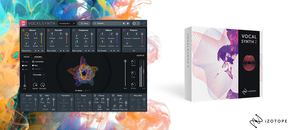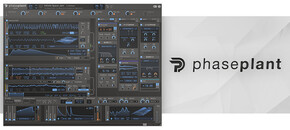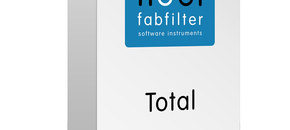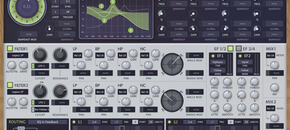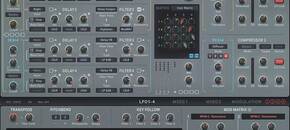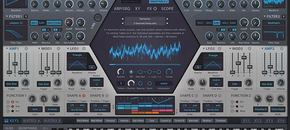Urs Heckmann's U-he is best known for the award-winning Zebra modular soft synth, and more recently the excellent Uhbik effects plug-ins. His latest venture, ACE (Any Cable Everywhere), is once again on a modular tip. But this time it's simpler (semi-modular), cheaper and if he's done his maths right, more fun to use, whether you're a synth newbie or seasoned knob twiddler.
ACE comes in plug-in form only (so no standalone) and is for Mac (RTAS/VDST/AU) and PC (VST). It uses a combination of proper analogue modelling (filters, oscillators and envelopes) and typical soft synth coding to deliver a modern take on the traditional modular synth. It's what Urs calls a "pimped-up ARP 2600 using modules from a Roland SH-7 with (almost) the patching flexibility of an EMS VCS3." In typical soft synth style it's stereo and polyphonic (though can also run in two monophonic modes: retrigger and legato).

On the technical front you have 24 potential output sources (including two VCOs, two LFOs, white and pink noise, and +5 volt constant voltage) and over 30 inputs (two ADSR envelopes, two filters and so on). In keeping with the semi-modular concept, the modules are essentially hard-wired in a standard oscillator/filter/envelope/amplifier configuration, so ACE makes a noise even if you have no cables connected. However, the real power lies in the ability to freely connect modules. ACE also has a further trick up its sleeve, as it uses internal oversampling not only for audio but also control signals. Rates vary depending on modules (anything from x2 to x16). ACE also includes a four-position quality setting, and this influences oversampling as well as CPU usage.
If this all sounds a bit scientific, you'll be glad to hear that the interface is anything but. Utilising three main screens (synth, tweak and patch) unless you're trawling through the 500 or so preset patches via the patch window, you'll spend the vast majority of time on the main "synth" page. If you're simply tweaking a preset, it's all pretty straightforward (note, there's a MIDI learn option for easy hardware controller assignment). Using patch cables is similarly easy: You simply drag between an output and an input and a cord appears (Reason anyone?). Outputs are coloured dark grey and inputs light grey so you shouldn't get too confused. And if the cables start to get in the way (which they can), right clicking over them brings up the option for "see thru" mode. Beyond this, you can daisy chain inputs one to the other, so one output can easily feed more than one input. And if dragging cables doesn't appeal, you can simply right click over an input and select a source output from the menu. In fact the only option that isn't available is the ability to temporarily "bypass" a patch connection.

The core modules are listed in the spec below, but here are some important aspects. Both oscillators have blendable saw/pulse waveforms, but VCO1 can also be switched to a softer peak/triangle waveform. VCO1 also gets a 3-mode sub-oscillator. By contrast VCO2 can be ring modulated by VCO1 and can also be synced to and cross modulated by VCO1. Both filter options are very similar (1, 2, 3 and 4-pole low pass, high pass, band pass and band reject), but filter 2 can be offset in various ways against filter 1. Finally, ACE has two output amplifiers (allowing easy hard-panned stereo sounds). These can only be controlled by either the envelopes or a gate option, so in practice you have to actually play a note to get any sound out of ACE. On ACE's tweak page you'll find three circuit bending controls: "slop," "crosstalk" and "osc cap failure." These round off the edges in one way or another, including saturation and low frequency thinning. And finally, you've got the "mapping generator," which adds a further layer of modulation but in a step format. At its simplest, you can use this to add predictable panning to a sound. More complex uses could include pitch or filter manipulation.
A spin through ACE's presets demonstrates an amazingly broad palette for what is by soft synth standards a reasonably simple design. These range from solid basses and rich evolving pads, to Kraftwerk-esque stacked tech sounds, percussion and some tasty effects. Particular favourites include BT Punchy Chicago, RL Tech House 88, RL Power Pad and RL So Progressive. This last example makes excellent use of ACE's envelope snap feature, which makes the envelope stages more extreme.
ACE has various other features that add to the sound palette, including a sample and hold option for LFO1, a mapping generator option for LFO2, chorus and digital delay on the outputs, and a very nice stack (or unison) feature with up to eight voices and individual pitch offset for each. There are also two multiple modules that allow combining and crossfading of signals, with the option to create ring modulation and amplitude modulation. Many of the presets make good use of these features, and I found deconstructing patches was a good way to appreciate how they work. Alternatively, if you like starting from scratch, there are four basic patch templates: PWM, Sample & Hold, Self Oscillation and Sync Lead.
It's easy to conclude that ACE is an excellent soft synth. But a number of reasons go into making that determination. The patch cord system means you can actually see as well as hear what's happening, so you won't be trawling through sub menus looking for an errant modulator. And even though it's not laden with synthesis techniques, effects and deluxe features such as sample importing, the modular design makes it incredibly flexible. What's more, the mapping generator and circuit bending functions indicate it's not all about old school sentimentality. Finally, and this is the big one, this synth sounds amazing: Crisp and dense in equal measure.
There are downsides. Although ACE is undoubtedly easy to use if you understand synths, getting it to do what you want does require skill and practice (and a good read of the manual). Novices looking for a preset playback instrument should probably look elsewhere. Secondly, when you're running at full tilt in "accurate" quality mode and with a full complement of eight stacked voices, CPU usage can be large; not the end of the world, but certainly a consideration if you're running other CPU-draining plug ins. But these are both minor niggles about what is fundamentally a fantastic piece of software.
Ratings:
- Cost: 5/5
- Versatility: 4/5
- Easie of use: 4/5
- Soun: 5/5
Overall Score: 4.5/5
Original Source: Resident Advisor

